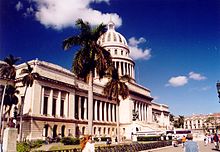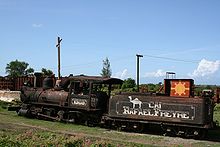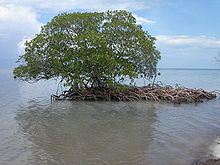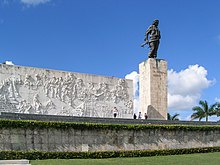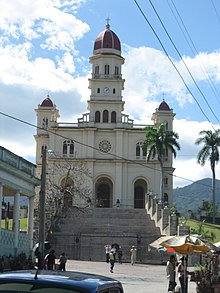Tourism in Cuba
This article deals with tourism in Cuba , general information can be found in the main article Cuba .
History of tourism in Cuba
The beginning of mass tourism in Cuba was triggered by prohibition in the United States . Cuba became a popular travel destination for Americans because it was close to Florida and it was not subject to any gambling or alcohol restrictions as in the USA. Havana offered nightclubs and gaming rooms like Las Vegas later did . This was supplemented by a pleasant climate, beaches and excessive prostitution .
After the Cuban Revolution in 1959 , a number of seedy eateries were closed. Due to the US embargo that was imposed a short time later, tourism in Cuba lost its importance, as the hitherto largest country of origin was no longer allowed to travel to Cuba due to the strict embargo regulations. All direct air and ship connections were interrupted by the USA.
Since there was hardly any potential for wealthy guests in Latin America and there were no efficient flight connections to Europe, it was difficult to attract new guests. Only a small number of tourists, especially from the Soviet Union and the Eastern Bloc countries , traveled to Cuba over the next thirty years. Nevertheless, new tourist facilities were designed, but they were mainly built for Cuban guests.
In the second half of the 1980s, the Cuban leadership revitalized international tourism as a new industry for generating foreign exchange income . After the collapse of the Soviet Union and the Eastern Bloc and the economic crisis in Cuba , the importance of the sector grew suddenly. Internationally active tourism companies have been setting up joint ventures with state tourism companies since the early 1990s , which set up and operate hotels and tourist facilities mainly in the main tourist areas. The high tips in foreign currency attracted many highly qualified Cubans into jobs in the tourism industry. Tourism employees are also specially trained at universities in the country with specially established courses.
In order to increase the number of tourists, which has fallen since 2005 after a year-long increase, various measures were decided in 2007, such as lowering landing fees at airports, lowering kerosene prices to world market level and faster processing of tourists upon arrival.
In 2010 the number of foreign visitors rose by 4% to 2.5 million (2009 2.4 million) tourists. In 2011 over 2.7 million people visited the island. The Canadians made up the largest proportion, ahead of the British, Italians, Spaniards and Germans, although the group of Cubans abroad, an important factor since US President Obama eased travel restrictions in the USA in 2009 , is not shown separately from the official statistics. In 2016, the number of US tourists rose by 74 percent, in 2017 by 119 percent compared to the previous year, to 620,000 visitors, with the number falling again in the second half of the year following the tightening of travel regulations for US citizens to Cuba under President Trump was. Americans make up the second largest group of visitors after the Canadians . Overall, Cuba received 4.25 million tourists in 2017, which corresponds to an increase of 19 percent.
Tourism today
Package tourism
Today's package tourism concentrates on a few areas, in particular Varadero , the Havana region , the Valle de Viñales , Cayo Coco and the north coast near Holguín ( Guardalavaca Beach ). There are also a number of other hotels throughout Cuba for organized tours.
Individual travel
Round trips by rental car are popular. Private accommodation (→ Casas particulares de alquiler ) is offered in all tourist locations.
Round trips by train , the state bus company Viazul , comparatively inexpensive intercity taxis and bicycles are also possible. The second Cuban intercity bus company, Astro , is normally only available to Cubans and therefore only offers a very limited number of foreign exchange places.
Main destinations for individual travelers are the capital Havana , the region around Pinar del Río and Viñales , Santiago de Cuba , Trinidad and Baracoa .
Health tourism
Due to the high number of doctors and a developed health system, Cuba offers the conditions for health tourism . Tourists combine their vacation stay with medical treatment or travel to Cuba for special treatments such as eye surgery and dental treatment. As part of the Misión Milagro (miracle), patients from developing countries are given eye operations.
Sex tourism
Prostitution is a clear phenomenon of tourism in Cuba, mainly due to the large gap between the average income of foreign visitors and that of Cubans, but also because of the still low income opportunities in the extremely regulated economy . When international mass tourism was promoted as the main source of foreign exchange during the extreme economic crisis of the first half of the 1990s, sex tourism was an important factor in the rapid growth in visitor numbers. After the eradication of prostitution, which is primarily related to tourism, had long been celebrated as an important success of the revolution, sexually suggestive images of seductive young Cuban women in bikinis became part of state tourism advertising for the first time since the 1950s. In 1991, the three state tourism companies Cimex, Cubatur and Cubanacán invited a delegation from the men's magazine Playboy to a tour of Cuba for the first time , whereupon nude photos of Cuban photo models were printed in the various international editions of the magazine, some of them photographed on beaches. In addition to organized prostitution, despite a general ban, a large gray area of casual prostitution ( jineterismo ) developed, with a social ostracism of this service branch in Cuba, which is less pronounced than in Latin American countries, which are more Catholic. In 1992, Castro confirmed the resurgent phenomenon of prostitution in a speech to the Cuban National Assembly, emphasizing, however, that, unlike in the past, women no longer sold their bodies out of necessity and that “Cuban prostitutes are extremely well educated and very healthy “, After all , Cuba is“ the country with the lowest AIDS rate ”. His sister-in-law Vilma Espín , the chairwoman of the state women's association FMC , declared in 1995, after prostitution had taken on enormous proportions, that Cuban prostitutes were “weak women” and “a great shame for their country” that prostitution had to be cleaned up. Around this time the government began to step up measures to curb prostitution, which Castro detailed in another speech to the National Assembly in November 1998. In 2004, US President George W. Bush accused the Cuban government of supporting sex tourism, which Castro indignantly rejected. Even in recent times, however, sex tourism has remained clearly present in Cuba.
accommodation
Hotels
There are hotels in Cuba in every category. Hotels of higher categories are mostly comparable with European standards. Hotels are mainly found in package tour areas and provincial capitals.
Casas particulares de alquiler
For individual tourists, the hotel alternative is accommodation in Casas particulares ( casa particular de alquiler = Spanish for private rental accommodation ). This is the name given to pensions in Cuba that are made available by private landlords. In contrast to state hotels, these are usually cheaper and more comfortable. As a tourist, you also have closer contact with the Cuban population. They are comparable with the bed & breakfast accommodations common in Anglophone countries .
The accommodation in a private house usually consists of a locked room in a private house or the private residence of the owner. Additional comfort features are usually air conditioning and a private bathroom. In contrast to other apartments in Cuba, running hot and cold water is a matter of course. Rich and high-quality meals, such as breakfast and dinner, are often also offered for an additional fee.
A landlord who offers rooms on a foreign exchange basis must have a state license and pay high taxes regardless of the occupancy on this license. The accommodation of tourists in unlicensed private houses or apartments can lead to considerable problems for the landlord, combined with high fines or even confiscation of the house.
Special regulations for Cubans
The restrictions on hotel access for Cubans, which contradict the Cuban Constitution and were introduced in the early days of international mass tourism in the 1990s, were lifted in April 2008. Cubans, however, have to pay in CUC like foreigners in these previously restricted hotels . Hotels in which you can stay overnight against Moneda Nacional are of the standard below the hotels for foreigners.
Cubans are not allowed to use motorized watercraft for tourist purposes, even if they live legally and permanently abroad and are only visiting Cuba. This prohibition applies in particular to excursion boats - such as catamarans for diving or snorkeling tours or yachts for tours, such as those offered in various tourist centers. Theoretically, foreigners can apply for a special permit for their Cuban spouses at the locally responsible port administration by submitting a written application, which must contain precise information on the date and purpose of the requested use of a watercraft and the original marriage certificate as well as photocopies of the personal documents of both spouses are to be attached. Leaving the Cuban territorial waters - e.g. B. on a cruise ship or a sailboat - is illegal for Cubans in any case.
For most sights and museums, Cubans only pay a greatly reduced admission price, in the best case in the ratio of 1: 1 between peso convertible for tourists and Moneda Nacional for Cubans.
Entry and exit
entry
For entry you need a tourist card, which is used as a receipt instead of the stamp in your passport . This serves to avoid restrictions on possible later entry into the USA . The tourist card always consists of 2 parts, which are essentially copies. The first part remains with the immigration authorities upon entry, the second part must be presented and handed in again upon departure. Tourists can import personal belongings, but must declare valuables and officially export them again (although exports are practically never checked). The valuables should correspond to the usual travel needs, such as B. only one laptop and one digital camera per person. Customs and detailed baggage checks are carried out if there are any abnormalities upon entry. It is forbidden to import air conditioners and some other devices as well as propaganda material. Furthermore, the address of the accommodation must be given on entry and, in particular, a return ticket must be shown. GPS devices require prior registration, but smartphones with integrated GPS receivers are practically not affected by this and their unannounced import is tolerated. Since May 2010, a (foreign) health insurance valid in Cuba has to be proven upon entry . A presentation of the relevant document can be requested upon entry. If you cannot provide evidence, you may be obliged to take out health insurance on site.
Departure
The export of cigars bought privately or on the black market is restricted. If these maximum quantities are exceeded, an official purchase must be documented accordingly. The export of so-called Cuban cultural assets , including privately acquired fine arts , is also restricted.
Flight connections to Cuba
Since Cuba is not yet one of the most popular holiday destinations in the world, the number of flights available there is also limited, which not only results in comparatively high flight prices during the main holiday periods.
The following airports are important for international air traffic:
- Havana José Martí Airport ( Aeropuerto International José Martí )
- Varadero Airport ( Aeropuerto International Juan Gualberto Gómez )
- Cayo Coco Airport ( Aeropuerto International Jardines del Rey )
- Holguín Airport ( Aeropuerto International Frank País García )
- Santiago de Cuba airport
For other airports, see the list of airports in Cuba
Sights by provinces
Isla de la Juventud
The Isla de la Juventud (dt. Island of Youth , also Isla de Pino , dt. Pine Island) is the largest side island of Cuba . It is not a separate province, but is treated as a special administrative area . The island is located in the Gulf of Batabanó on the Caribbean side of Cuba and is part of the Archipiélago de los Canarreos . Nueva Gerona is the main town, and with around 15,000 inhabitants, it is also the largest city on the island.
Pinar del Río
Pinar del Río is the westernmost province of Cuba. Its capital is Pinar del Río . With 10,931 km² it is Cuba's third largest province and is bordered in the east by the province of La Habana . It borders the Gulf of Mexico in the north and the Caribbean in the south .
- Cueva del Indio
- Cueva de los Portales
- Cueva de San Miguel
- Caverna de Santo Tomás
- Cayo Levisa
- Península de Guanahacabibes
- Pinar del Río
- San Diego de los Baños
- Soroa
- Las Terrazas
- Valle de Viñales (UNESCO World Heritage Site)
La Habana
La Habana is a province in northwest Cuba, which is located around the Cuban capital of the same name . The province is administered from the capital, but the capital itself is an independent province.
- Playa Jibacoa
Ciudad de La Habana
Ciudad de La Habana (Havana ( Spanish ) La Habana , full name San Cristóbal de La Habana ), is the capital of Cuba and at the same time an independent province. With 2,130,431 (2011 census), Havana is the fourth largest city in the Caribbean after Caracas and Maracaibo ( Venezuela ) and Santo Domingo ( Dominican Republic ) . The old town of Havana has been a World Heritage Site since 1982 .
Matanzas
Matanzas is a province in northwest Cuba, east of the capital La Habana . The provincial capital of the same name has around 120,000 inhabitants.
Cienfuegos
Cienfuegos is a province in south-central Cuba. The capital is the city of the same name . The sugar production is dominant, Cienfuegos has the largest sugar exporting port of Cuba. Crab fishing is an important industry.
- Old town of Cienfuegos (UNESCO World Heritage Site)
- Jagua Castle
- Jardín Botánico de Cienfuegos
Villa Clara
Villa Clara is a province in central Cuba. Its capital is Santa Clara . Besides the capital, Placetas , Camajuaní , Remedios and Caibarién are important cities . The sugar industry and some tourism are the province's main sources of income. Before the administrative reform of 1975, Villa Clara formed the province of Las Villas together with Santa Clara and Sancti Spíritus .
The longest Cuban river, the Río Sagua la Grande, flows into the Atlantic here.
- Cayo Santa María
- Baños de Eleguea
- Old town of Remedios
- Santa Clara
- Mayanigua
Sancti Spiritus
Sancti Spíritus is a province in central Cuba. The capital is the city of Sancti Spíritus.
The sugar industry and animal husbandry are the main sources of income. Rice and tobacco are also grown. Tourism is of enormous economic importance in the province. Trinidad , until the 19th century one of the most important sugar metropolitan Cuba is since 1998 km together with the 20 outlying sugarcane plantations of Valle de los Ingenios World Heritage of UNESCO .
- Playa Ancón
- Old town of Sancti Spíritus
- Trinidad (UNESCO World Heritage Site)
- Topes de Collantes
- Valle de los Ingenios ( Iznaga ) (UNESCO World Heritage Site)
Ciego de Ávila
Ciego de Ávila is a province in central Cuba. The capital is the city of the same name, Ciego de Ávila , which is located on the Carretera Central road . The second largest city is Morón near the north coast. The province was part of Camagüey Province until 1975 .
The cayos (part of a 400 km long coral reef with small and tiny islands) are located off the north coast . Their extensive tropical vegetation and shallow water areas provide habitat for over 150 species of birds. The largest colony of flamingos lives around Cayo Coco . A large part of the islands is now designated as a nature reserve.
There are several lakes between Morón and the north coast, the largest of which is the Laguna de la Leche ( Milk Lake ). It is also the largest freshwater reservoir in Cuba. The peculiar white color of the water comes from limestone deposits.
There are mangrove forests on the south coast . In agriculture, cattle breeding (central part), sugar production, pineapple and citrus fruits dominate.
Camaguey
Camagüey is a province in central Cuba. The capital is the city of the same name with around 300,000 inhabitants. Other important cities are Florida and Nuevitas. The province consists essentially of flat land. Sugar production and cattle breeding are dominant.
In the southeast the province borders on the Gulf of Guacanayabo .
- Cayo Sabinal
- Old town of Camagüey (UNESCO World Heritage Site)
- Santa Lucía Beach
Las Tunas
Las Tunas is a province in eastern Cuba. The capital is the city of the same name , which is also called Victoria de Las Tunas .
In the south the province borders on the Gulf of Guacanayabo .
Granma
Granma is a province in southeastern Cuba. The capital is Bayamo .
The province lies to the east on the Gulf of Guacanayabo and to the west it comprises a significant part of the Sierra Maestra . There, on the border with the neighboring province of Santiago de Cuba, is the highest point in the country, the Pico Turquino ( 1974 m ).
The southeast between Niquero and Cabo Cruz is today Granma National Park .
Holguín
Holguín is a province in northern eastern Cuba. The capital is the city of the same name . Sugar and coffee production and mining are economically important.
- Bahia de Bariay
- Chorro de Maita Indian cemetery
- Rafael Freyre (Santa Lucía), Guardalavaca Beach
- Parque Natural Bahía de Naranjo
- Parque Natural Cayo Saetía
Santiago de Cuba
Santiago de Cuba is a province in eastern Cuba. The capital is the city of the same name, Santiago de Cuba, with 554,000 inhabitants. Palma Soriano (125,000), Contramaestre (88,000), Mayarí (80,000), San Luis (65,000) and Songo-la Maya (50,000) are other important cities.
Agriculture ( bananas , cocoa and coffee ), mining (iron, nickel) and tourism are the main sources of income in the province.
- Castillo del Morro
- Pilgrimage Church of El Cobre
- The Baconao Park with
- the Granjita Siboney ( Siboney Farm )
- Gran Piedra rock monolite
- the valle prehistórico (= prehistoric valley )
- Pico Turquino
- Old town of Santiago de Cuba
Guantánamo
Guantánamo is a province in south-eastern Cuba. The capital is the city of the same name .
Guantánamo is known internationally through the US military base Guantánamo Bay , where a prison camp for so-called illegal Islamic fighters is currently operated.
- Baracoa
- Boca de Yumurí
- La Farola pass road
- Parque Nacional Alejandro de Humboldt (UNESCO World Natural Heritage)
- Table Mountain El Yunque
literature
- Stephanie Nau: Local Actors in the Cuban Transformation: Reactions to International Tourism as a Factor of Openness: a socio-geographical contribution to current Cuban research from an emic perspective. Self-published subject geography at the University of Passau, 2008, ISBN 978-3981162325
- Peter M. Sanchez and Kathleen M. Adams: The Janus-Faced Character of Tourism in Cuba , in: Annals of Tourism Research Vol 35/1, pp. 27–46, 2008, Analysis of the Social Impacts of Tourism in Cuba (English)
Web links
- Cuban Tourist Office (country and travel information, pictures, videos, weather)
- Tourism information at Cubanacan ( Spanish / English )
- Customs information (Spanish / English)
Individual evidence
- ↑ Basler Zeitung baz.ch: Cuba: Offensive against weakness in the tourism industry ( Memento of the original of September 30, 2007 in the Internet Archive ) Info: The archive link was automatically inserted and not yet checked. Please check the original and archive link according to the instructions and then remove this notice. dated June 27, 2007
- ^ Spiegel-Online: Cuba eases entry for tourists from May 9, 2007
- ↑ Oficina Nacional de Estadísticas: Llegada de visitantes-Información Adelantada - Diciembre 2011 (PDF; 75 kB) from January 20, 2012, accessed on January 23, 2012 (Spanish)
- ↑ Oficina Nacional de Estadísticas: Llegada de visitantes internacionales por países (PDF; 88 kB) from January 25, 2012, accessed on January 25, 2012 (Spanish)
- ↑ Jeff Franks (Reuters): Arab Spring and US reforms make Cuba a tourist hotspot in: Chicago Tribune of January 24, 2012, accessed on January 25, 2012 (English)
- ^ Corrigents a Josefina Vidal: Adicionó erróneamente 100 mil turistas de EE.UU. a Cuba. In: CyberCuba. January 7, 2018, Retrieved January 8, 2018 (Spanish).
- ↑ Despite Trump: US tourism in Cuba is growing , Cuba today, January 6, 2018
- ↑ Charles Trumbull: Prostitution and Sex Tourism in Cuba ( Memento of September 7, 2014 in the Internet Archive ) (PDF, 16 pages; 189 kB), paper on the 11th annual conference of the Association for the Study of the Cuban Economy , August 2001, accessed on September 4, 2013
- ↑ Amalia L. Cabezas: Economies of Desire: Sex and Tourism in Cuba and the Dominican Republic, Philadelphia: Temple University Press 2009 (English)
- ^ Juan Villoro: Kubanische Zeit , in: Lettre international from summer 2006, accessed on December 8, 2012
- ^ Coco Fusco: Jineteras - Reiterinnen, in: Lettre international from summer 1999, accessed on December 8, 2012
- ^ A b Susan Eva Eckstein: Back from the Future: Cuba under Castro,, London: Routledge 2003, p. 105, quoted from Paul D'Amato: Cuba: Image and reality , in: International Socialist Review of January 2007, accessed on December 8, 2012
- ^ Cuba Libre - Castro's beautiful daughters break free , in German Playboy from October 1993
- ^ Mette Louise B. Rundle: Tourism, Social Change, and 'jineterismo' in Contemporary Cuba ( Memento from September 14, 2013 in the Internet Archive ) (PDF; 45 kB), in: The Society For Caribbean Studies Annual Conference Papers Vol. 2 , 2001 (English)
- ↑ Douglas Farah: Catering to Foreigners Instead of Cubans Puts Castro on Defensive , in: Washington Post, August 9, 1992, accessed on September 4, 2013 (English)
- ^ Samuel Farber: Cuba Since the Revolution of 1959: A Critical Assessment, Chicago: Haymarket 2011, p. 195 (English)
- ↑ Ludwig Witzani: Cubans see red , in: Die Zeit from January 26, 1996, accessed on December 8, 2012
- ↑ Castro comments on Cuban prostitution , Reuters report on CNN of May 1, 2001, accessed via LatinAmericanStudies.org on December 8, 2012
- ↑ Lisa Erdmann: Cuba: From the Revolution to Prostitution , in: Spiegel Online from July 27, 2004, accessed on December 8, 2012
- ↑ Américo Orlando Rodríguez: Sex tourism - big business in Cuba , in: Reutlinger General-Anzeiger of December 5, 2009, accessed on December 8, 2012
- ↑ Denis Krah: Havana: Cuba's famous waterfront , in: Merian from August 2010, accessed on December 8, 2012
- ↑ Cubanet.org: Nuevo reglamento endurece condiciones alquileres ( Memento of October 13, 2007 in the Internet Archive ) of July 31, 2003
- ↑ Mauricio Vicent: Los cubanos podrán alojarse en hoteles , in: El País of March 14, 2008, accessed on August 26, 2013 (Spanish)
- ↑ EFE: Los hoteles de lujo ahora también son para cubanos , in: Infobae of March 31, 2008, accessed on August 26, 2013 (Spanish)
- ↑ Fernando Ravsberg: Barquito de papel ... , in: BBC Mundo from March 28, 2013, accessed on August 26, 2013 (Spanish)
- ↑ Items requiring import authorization ( Memento from February 28, 2014 in the Internet Archive )
- ↑ http://www.vielfliegertreff.de/mittel-und-sued Amerika/8602-ab-01-05-2010-weise-ueber-krankenversicherung-zur-einreise-nach-kuba- erzutlich.html
- ↑ http://latina-press.com/news/22098-ab-sofort-krankenversicherungspflicht-bei-einreise-nach-kuba/
